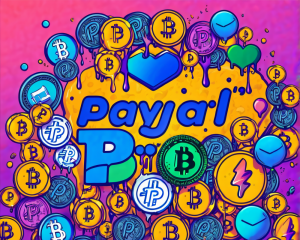Bitcoin’s Resilience Amidst Corporate Blockchain Moves
Bitcoin (BTC) has been strutting its stuff around the $13,500 mark, keeping investors on their toes like a dancer at a wedding reception. Just as PayPal waltzes into the crypto dance floor, many believe its entry may just usher Bitcoin into the limelight it deserves. Businesses are starting to see cryptocurrencies not just as speculative assets but as serious players in the financial realm.
JPM Coin: The New Kid in Town
With the recent launch of JPM Coin, JPMorgan Chase has taken a step that might feel like that ambitious friend who runs a marathon after a few light jogs. Since its announcement back in 2019, the token—backed by big banking bucks—is primed to revolutionize cross-border monetary transactions. The aim? Cutting down costs, streamlining processes, and helping banks save enough cash to treat themselves to a fancy dinner or two. Sounds fancy, but does it mean anything significant in the market?
The Impact of Centralized Tokens
Brian Behlendorf, the executive director at Hyperledger, cautioned that while the JPM Coin could ease some costs for professional investors and businesses, everyday consumers might not even notice its effects. Think of it this way: it’s like ordering a gourmet burger but only finding out at the end that it didn’t even come with fries. So, will it change the payment landscape? It’s possible, but it’s more of a convenience than a seismic shift.
Blockchain: Ready for Business
Experts, including Paul Brody from Ernst & Young, argue that while blockchain’s potential is now being recognized, it has quietly been doing the heavy lifting for businesses for years. If JPM Coin helps other enterprises to embrace digital contracts and payments, it introduces a new level of efficiency—like those self-checkout kiosks at grocery stores that we promise we’ll learn how to use one day.
JP Morgan’s Blockchain Playground: Onyx
What’s more? JPMorgan has launched Onyx, a dedicated team focused on its blockchain ambitions. They seem prepared to transform those lofty ideas into reality—like turning that half-baked bread recipe into a delectable loaf everyone wants a slice of. With over 100 staff members, Onyx aims to make big strides in commercialization. And let’s not forget the rename of their Interbank Information Network to “Liink”—because if there’s anything the finance world loves, it’s cutesy names that make them sound more approachable!
The Fusion of Finance and Technology
We’re witnessing a wave of change where blockchain could flip the traditional banking model on its head. By opting to use decentralized frameworks, banks have the potential to make transactions not only cheaper but also far more transparent. However, let’s not turn a blind eye to the fact that the banking world has been digital for such a long time already, and while blockchains add a sprinkle of security and techiness, they’re competing against established digital payment giants that already exist in the landscape.
Balancing Convenience and Privacy
Still, as convenient as digital payments are, we must tread carefully to protect our fiscal privacy. Physical cash, with its veil of anonymity, serves a purpose that many digital solutions can’t replicate. As Brian aptly puts it, “We should be very wary of giving up the anonymity that physical cash provides.” So, as we gallivant further into this digital era of transactions, perhaps it’s time we ask ourselves what we’re willing to give up in the name of convenience.















+ There are no comments
Add yours